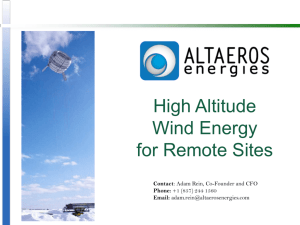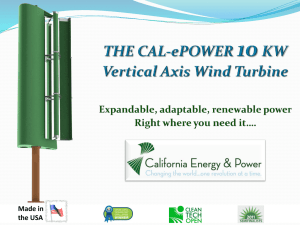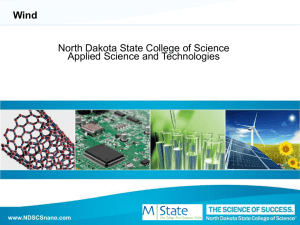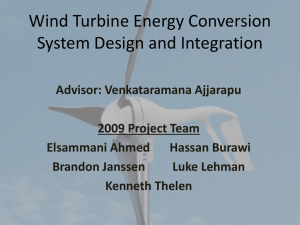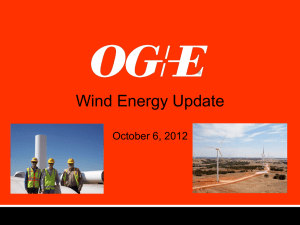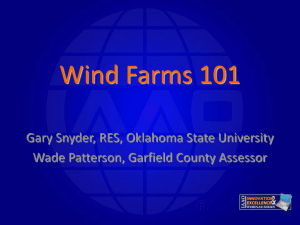File - Undergraduate Projects
advertisement
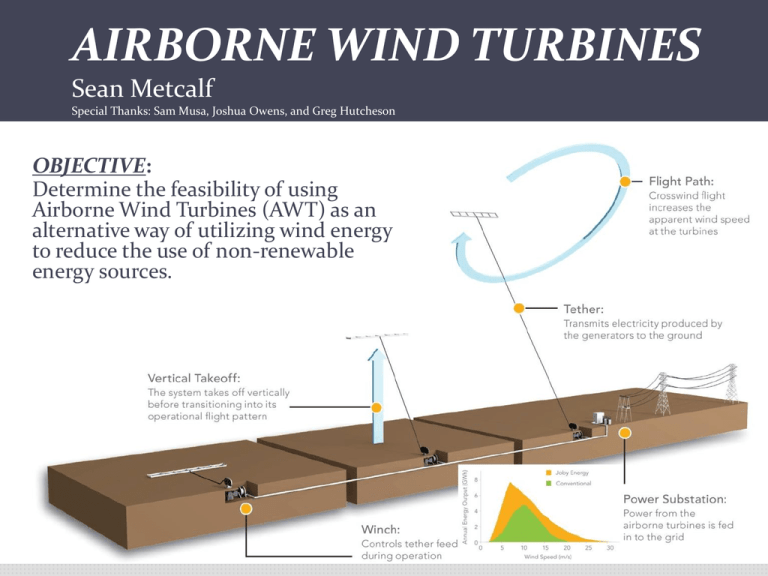
AIRBORNE WIND TURBINES Sean Metcalf Special Thanks: Sam Musa, Joshua Owens, and Greg Hutcheson OBJECTIVE: Determine the feasibility of using Airborne Wind Turbines (AWT) as an alternative way of utilizing wind energy to reduce the use of non-renewable energy sources. BACKGROUND INFO: Figure 1: Description of how the AWT operates • Makani Power, Joby Energy, KiteFarms and KiteGen have developed working prototypes and designs for high altitude AWTs • Desired to produce more and consistent energy more cost effective than conventional solar and wind power • Developed fixed-wing AWT, operational at altitudes of 250 to 600 meters. • Makani Power tested prototype capable of 30 kW production. RESEARCH & ANALYSIS: • Research feasibility of utilizing AWT’s as an alternative source to harvest wind energy in the effort to reduce the use of nonrenewable energy sources • Conduct thermodynamic analysis and compare maximum power output for 30 kW AWT and a 30 kW conventional wind turbine Figure 2: Makani M30 AWT technical specifications COMPARISON: • AWT offshore wind farm applications • AWT’s perform better at low wind speeds than conventional wind turbines • Can produce about twice the power of a traditional wind turbine the same size • Wind power represents %32 of all new electric capacity additions in the U.S. for 2010 • Accounts for $14 billion in new investment • U.S. wind power capacity reached 50,000 MW, enough electricity to power 13 million homes annually Figure 3: Wind energy production comparison (wind power information and figure used from www.energy.gov ) SAFETY & IMPACT: • Operates below altitude of commercial flights and above the height of migratory birds • 90% less material than a conventional turbine • Can operate in hurricane conditions with winds in excess of 50 m/s with gusts reaching 80 m/s • During extreme weather, it can land autonomously until conditions normalize Figure 4: Comparison of area and height between conventional turbines and the AWT ANALYSIS: Assumptions: • Reversible process • Control volume • Heat Transfer and Potential Energy are negligible • Steady-State • Constant wind velocity Thermodynamic derivation for rate of work or power output for a wind turbine using assumptions: Note: Equations uses constant for Betz ‘ Law, which limits the theoretical max. power efficiency for any turbine design to be %59. Observations: It is observed that the energy available in the wind for a turbine is only in the form of kinetic energy. The total power that can be derived from wind using a wind turbine is: CONCLUSION: • AWT system is feasible because it yields more energy more often because it taps into a more consistent and powerful wind at a higher altitude • Doesn’t harvest most of the energy available to it, but it harvests what would otherwise remain untouched • Promising solution for harvesting offshore and land renewable wind energy with low initial investment • Mechanical, electrical, and computer automation systems maintenance for AWT’s would create more jobs Table 1: Using the above Power equation the following table shows the power yield for a 30 kW conventional turbine (model # FD 10-30/12 manufactured by Wind Resource Energy) and a 30kW AWT (model M30 Manufactured by Makani). Type Horizontal Shaft Wind Turbine Airborne Wind Turbine Make/Model WER FD 10-30/12 (30kW) Makani M30 (30kW) Sky Area 78.5m2 (5m radius) 1809m2 (8meter wing span) wind Speed (m/s) Available power (W) Actual output (w) % total Energy Available power Actual output (W) (w) % total Energy 7 9695.4 5300 54.7% 223313.3 15000 0.07% 10 28266.5 1800 6.37% 651059.1 30000 4.6% 13 62101.5 34000 54.7% 1430376.8 30000 2.1% 16 115779.5 29000 25.0% 2666738 30000 1.1% References: • http://www.makanipower.com/how-does-it-work/ • http://news.harvard.edu/gazette/story/2009/03/the-key-to-energy-independence-gofly-a-kite/ • http://online.wsj.com/article/SB10000872396390444230504577617971067036752.html • http://www.jobyenergy.com/faq • http://web.mit.edu/windenergy/windweek/Presentations/Wind%20Energy%20101.pdf • http://energy.gov/articles/energy-report-us-wind-energy-production-andmanufacturing-surges-supporting-jobs-and
